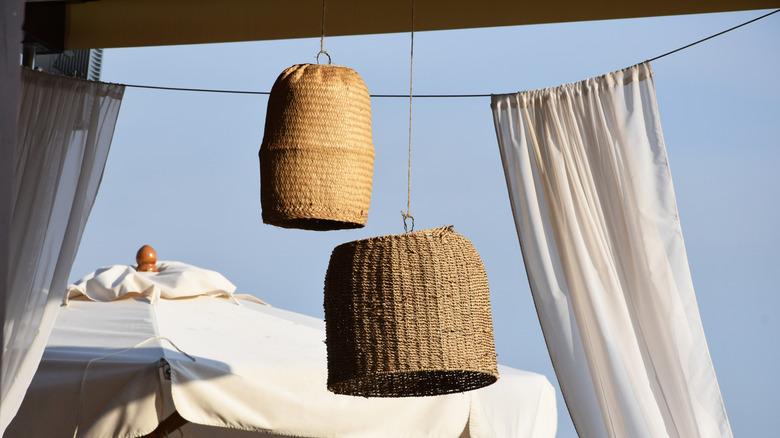Why You Should DIY A Privacy Wall (And How To Do It)
We may receive a commission on purchases made from links.
Having private, usable outdoor space during the good weather months is a major perk for any renter or homeowner. The downside for those with neighbors is that sometimes that space isn't as private as you'd like. One way to enjoy the outside world without the feeling that you're being watched is to build a privacy wall. Smaller than a privacy fence but more substantial than a screen, privacy walls provide shade, reduce wind and noise, and improve the look of your deck or patio.
By going the DIY route, you can guarantee that the wall is perfect for the dimensions of your space. Unlike some of the ready-made alternatives that are designed to be inserted into the ground, you also make a renter-friendly temporary structure like this one by Actually Alli DIY on YouTube. The entire project can be completed with five materials: 1x2 boards for the support beams, 1x4 boards for the horizontal slats, sandpaper, wood glue, and 1.5-inch brad nails. As for tools, you'll need something to cut the boards with, a brad nailer, and a speed square.
Now they see you, now they don't
As Alli demonstrates, the build is quick and easy. After cutting the supports and slats to the desired lengths (Alli chose to make it 5 feet tall but later trimmed a few inches off the supports), it's just a matter of sanding them down, attaching the horizontal slats to the side support beams with glue and brad nails, then attaching the center beam. Leaving space between the boards keeps the wall from being a total barrier for light, sound, and sight, but slatted boards do allow for better airflow. They are less likely to turn into a sail during strong gusts, and they're stronger because they are individually attached to the supports and not to one another. Slats are also easier to replace when broken.
Paint is optional, but because the wall will live outside, you will want to add some sort of waterproofing sealant so that it lasts more than one season. To secure the privacy wall to their existing balcony without angering the landlord, Alli recommends using large zip ties that match the color of the wall and adding them at various points along all three of the supports.
When is a wall not a wall? When it's a curtain
For a more flexible option that doesn't require cutting or nailing wood, there are floating curtains. Curtains are great for adding privacy to a porch and windows, but you don't need an existing frame to hang them. With a freestanding post or a pole set in a bucket of concrete, a vinyl-coated steel wire rope kit ($22 on Amazon), and an outdoor curtain with grommets ($15 on Amazon), you can DIY a divider that slides into place when you need it, and slides out of the way when you don't.
With a wire and curtain system, you get a temporary privacy wall that doubles as a moving blocker for the sun. It can be tied to one side during inclement weather, used as a makeshift projector screen on cozy nights, and is easy to disassemble and take with you when you move. Sandwiching magnets along the bottom will keep the curtain from billowing in the wind, but you may have to adjust the tension on the cable to account for the extra weight.

